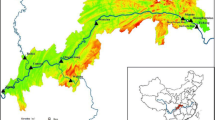Abstract
Based on hydrometric data and extensive investigations on water-extracting projects, this paper presents a preliminary study on water discharge changes between Datong and Xuliujing during dry season. The natural hydrological processes and human factors that influence the water discharge are analyzed with the help of GIS method. The investigations indicate that the water-extracting projects downstream from Datong to Xuliujing had amounted to 64 in number by the end of 2000, with a water-extracting capacity up to 4,626 m3/s averaged in a tidal cycle. The water extraction from the Changjiang River has become the most important factor influencing the water discharge downstream Datong during dry season. The potential magnitude in water discharge changes are estimated based on historical records of water extraction and a water balance model. The computational results were calibrated with the actual data. The future trend in changes of water discharge into the sea during dry season was discussed by taking into consideration of newly built hydro-engineering projects. The water extraction downstream Datong in dry season before 2000 had a great influence on discharges into the sea in the extremely dry year like 1978–1979. It produced a net decrease of more than 490 m3/s in monthly mean discharges from the Changjiang into the sea. It is expected that the water extraction will continually increase in the coming decades, especially in dry years, when the net decrease in monthly mean water discharge will increase to more than 1000 mVs and will give a far-reaching effect on the changes of water discharge from the Changjiang into the sea.
Similar content being viewed by others
References
Chen Xiqing, Chen Jiyu, 2000. Proposal to study and control of the decrease tendency in discharge of the Changjiang River entering the sea in the dry season.Science and Technology Review, (2): 39–40. (in Chinese)
Chen Xiqing, Zong Yongqiang, Zhang Erfenget al., 2001. Human impacts on the Changjiang (Yangtze) River basin, China, with special reference to the impacts on the dry season water discharges into the sea.Geomorphology, 41: 111–123.
Chen Xiqing, Zhang Erfeng, Xu Jiangang, 2002. Large and episodic decrease of water discharge from the Yangtze River to the sea during the dry season.Hydrologwal Sciences-Journal, 47(1): 1–9.
Editorial Board of China Water Resources Almanac, 1997. Almanac of China Water Resources. Beijing: Chinese Water Conservancy and Hydroelectricity Press. (in Chinese)
Mao Zhichang, Shen Huanting, Huang Qinghui, 2001. The utilization of fresh water resources and the reservoirs of avoiding salt water and storing fresh water in the Changjiang estuary.Resources and Environment in the Yangtze Basin, (1): 34–42. (in Chinese)
Mao Zhichang, Shen Huanting, Xu Pengling, 2000. The pattern of saltwater intruding into the Changjiang Estuary and the utilization of fresh water.Acta Geographica Sinica, 55(2): 243–250. (in Chinese)
Wang Chaojun, Zhang Mingdong, 1994. Impacts of Three Gorges Reservoir operation on salt water encroachment at the Yangtze River estuary.Yangtze River, (4): 44–48. (in Chinese)
Water Information Web, 2001. http://www.hwcc.com.cn. (in Chinese)
Author information
Authors and Affiliations
Rights and permissions
About this article
Cite this article
Erfeng, Z., Xiqing, C. & Xiaoli, W. Water discharge changes of the Changjiang River downstream Datong during dry season. J. Geogr. Sci. 13, 355–362 (2003). https://doi.org/10.1007/BF02837511
Received:
Accepted:
Issue Date:
DOI: https://doi.org/10.1007/BF02837511



